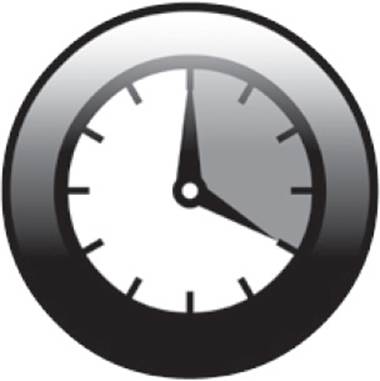Cracking the New SAT with 4 Practice Tests, 2016 Edition (2015)
Part VI. Taking the SAT
THE SAT IS A WEEK AWAY. WHAT SHOULD YOU DO?
First of all, you should practice the techniques we’ve taught you on lots of practice tests. If you haven’t done so already, take and score the practice tests in this book and online. You can also download a practice test from the College Board’s website, www.collegeboard.org.
If you want more practice, pick up a copy of our very own 500+ Practice Questions for the New SAT at your local bookstore or through our website, at PrincetonReview.com/bookstore.

Perfect Your Skills
In addition to taking the
practice tests in this book,
you should register your
book (See “Register
Your Book Online!”)
to gain access to
even more practice, as
well as other fantastic
resources to enhance
your prep.
Getting Psyched
The SAT is a big deal, but you don’t want to let it scare you. Sometimes students get so nervous about doing well that they freeze up on the test and ruin their scores. The best thing to do is to think of the SAT as a game. It’s a game you can get better at, and beating the test can be fun. When you go into the test center, just think about all those poor students who don’t know how to Plug In when they see variables in the answer choices.
The best way to keep from getting nervous is to build confidence in yourself and in your ability to remember and use our techniques. When you take practice tests, time yourself exactly as you will be timed on the real SAT. Develop a sense of how long 35 minutes is, for example, and how much time you can afford to spend on cracking difficult problems. If you know ahead of time what to expect, you won’t be as nervous.
Of course, taking a real SAT is much more nerve-racking than taking a practice test. Prepare yourself ahead of time for the fact that 35 minutes will seem to go by a lot faster on a real SAT than it did on your practice tests.
It’s all right to be nervous; the point of being prepared is to keep from panicking.
Should You Sleep for 36 Hours?
Some guidance counselors tell their students to get a lot of sleep the night before the SAT. This probably isn’t a good idea. If you aren’t used to sleeping 12 hours a night, doing so will just make you groggy for the test. The same goes for going out all night: Tired people are not good test takers.
A much better idea is to get up early each morning for the entire week before the test and do your homework before school. This will get your brain accustomed to functioning at that hour of the morning. You want to be sharp at test time.

Veg Out
Although preparation is
key to doing well on the
test, you shouldn’t exhaust
yourself trying to cram
information into your
head. Take some breaks
between study sessions to
relax, unwind, and
rest your mind.
Before dinner the night before the test, spend an hour or so reviewing or doing a few practice problems. The goal here is to brush up on the material, not to exhaust yourself by over-cramming.
Furthermore…
Here are a few pointers for test day and beyond:
1.Eat a good breakfast before the test—your brain needs energy.
2.Work out a few SAT problems on the morning of the test to help dust off any cobwebs in your head and get you started thinking analytically.
3.Arrive at the test center early. Everyone is headed to the same place at the same time.
4.You must take acceptable identification to the test center on the day of the test. Acceptable identification must include a recognizable photograph and your name. Acceptable forms of ID include your driver’s license, a school ID with a photo, or a valid passport. If you don’t have an official piece of ID with your signature and your photo, you can have your school make an ID for you using a Student ID form provided by the College Board. Complete instructions for making such an ID are found on the College Board’s website and in the SAT Registration Bulletin. According to ETS, the following forms of ID are unacceptable: a birth certificate, a credit card, or a Social Security card. Make sure you read all of the rules in the Registration Bulletin, because conflicts with ETS are just not worth the headache. Your only concern on the day of the test should be beating the SAT. To avoid hassles and unnecessary stress, make absolutely certain that you take your admissions ticket and your ID with you on the day of the test.
#1: Eat Breakfast
You’ll work better on a
satisfied stomach.
#2: Try Some Problems
Get your mind moving.
#3: Show Up Early
Leave time for traffic.
#4: Take ID
A driver’s license,
a passport, or a
school photo ID will do.
5.The only outside materials you are allowed to use on the test are No. 2 pencils (wooden, NOT mechanical), a wristwatch (an absolute necessity), and a calculator. ETS’s latest rule is that mechanical pencils are not allowed. We’re not sure why, but you should take lots of sharpened wooden pencils just to be safe. Digital watches are best, but if it has a beeper, make sure you turn it off. Proctors will confiscate pocket dictionaries, word lists, portable computers, and the like. Proctors have occasionally also confiscated stopwatches and travel clocks. Technically, you should be permitted to use these, but you can never tell with some proctors. Take a watch and avoid the hassles.
#5: Take Equipment
A few sharpened
No. 2 pencils, a watch,
and a calculator.
6.Some proctors allow students to bring food into the test room; others don’t. Take some fruit (especially bananas) with you. Save them until your break and eat outside the test room.
#6: Take Fruit or
Other Energy Food
Grapes or oranges can
give you an energy boost
if you need it.
7.You are going to be sitting in the same place for more than three hours, so make sure your desk isn’t broken or unusually uncomfortable. If you are left-handed, ask for a left-handed desk. (The center may not have one, but it won’t hurt to ask.) If the sun is in your eyes, ask to move. If the room is too dark, ask someone to turn on the lights. Don’t hesitate to speak up.
#7: Your Desk…
should be comfortable
and suited to your needs.
8.Make sure your booklet is printed legibly. Booklets sometimes contain printing errors that make some pages impossible to read. One year more than 10,000 students had to retake the SAT because of a printing error in their booklets. Also, check your answer sheet to make sure it isn’t flawed.
#8: Your Test…
should be printed
legibly in your booklet.
9.Make sure you darken all your responses before the test is over. At the same time, erase any extraneous marks on the answer sheet. A stray mark in the margin of your answer sheet can result in correct responses being marked as wrong.
#9: Bubble with Care
A stray mark
can hurt your score.
10.You deserve to take your SAT under good conditions. If you feel that your test was not administered properly (the high school band was practicing outside the window, or your proctor hovered over your shoulder during the test), call us immediately at 800-2-REVIEW and we’ll tell you what you can do about it.
#10: We’re Here for You
The Princeton Review is
proud to advise students
who have been mistreated
by ETS.